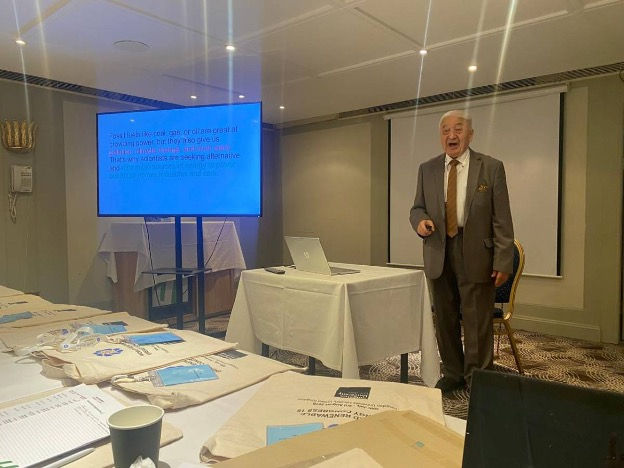Dr. Riyadh Al-Dabbagh: Green Renewable Energy is a Safer FutureJune 24, 2024Green renewable energy is a safer future through wider energy production and lower costs.
- info914452
- 6 days ago
- 4 min read
Dr. Riyadh Al-Dabbagh: Green Renewable Energy is a Safer FutureJune 24, 2024
Green renewable energy is a safer future through wider energy production and lower costs.
By Dr. Riyadh Al-Dabbagh London – Al-Zaman

Professor Dr. Riyadh Al-Dabbagh, President of the Manchester International Academy, international environmental expert, and former President of Al-Mustansiriyah University, participated in the Renewable Energy Conference held in Brighton, UK,
He explained that energy lies at the heart of the climate challenge – and is also the key to the solution, as a large share of the greenhouse gases surrounding the Earth and trapping the sun’s heat comes from energy production through burning fossil fuels to generate electricity and heat.
Dr. Al-Dabbagh stated that fossil fuels such as coal, oil, and gas remain by far the largest contributors to global climate change, accounting for more than 75% of global greenhouse gas emissions and around 90% of all carbon dioxide emissions.
To avoid the worst impacts of climate change, carbon emissions must be cut nearly in half by 2030 and brought to net zero by 2050. Achieving this requires abandoning dependence on fossil fuels and investing in clean, accessible, affordable, sustainable, and reliable alternative energy sources.

Renewable energy sources—abundant all around us through the sun, wind, water, waste, and geothermal heat—are naturally replenished and emit little to no pollutants or greenhouse gases.
Although fossil fuels still make up over 80% of global energy production, cleaner energy sources are gaining strength, with about 29% of electricity currently generated from renewables.

Here are five reasons why accelerating the transition to clean energy is the path toward a healthy, livable planet for present and future generations:
1. Renewable energy is everywhere around us
Al-Dabbagh noted that around 80% of the world’s population lives in countries that import fossil fuels—about 6 billion people relying on energy from abroad, leaving them vulnerable to geopolitical shocks and crises.
In contrast, renewable energy resources exist in all countries, and their potential has not yet been fully harnessed. The International Renewable Energy Agency (IRENA) estimates that 90% of the world’s electricity could and should come from renewable sources by 2050.
Renewables reduce reliance on imports, allowing countries to diversify their economies, shield themselves from volatile fossil fuel prices, promote inclusive economic growth, create jobs, and reduce poverty.
2. Renewable energy is cheaper
He added that renewable energy is in fact the cheapest form of power in most parts of the world today. Renewable technology costs are rapidly falling. The cost of electricity from solar power dropped by 85% between 2010 and 2020, while onshore and offshore wind fell by 56% and 48% respectively.
Because of these lower costs, renewable energy is increasingly attractive everywhere, including in low- and middle-income countries, where most additional electricity demand will arise. Declining prices create a real opportunity to provide much of the new energy supply in coming years from low-carbon sources.
By 2030, low-cost renewable electricity could provide 65% of global power supply, and by 2050, renewables could decarbonize 90% of the energy sector, drastically cutting emissions and mitigating climate change.
According to the International Energy Agency (IEA), although solar and wind costs in 2022–2023 remained above pre-pandemic levels due to higher commodity and shipping prices, their competitiveness has improved further because fossil fuel prices—especially gas and coal—rose even more sharply.
3. Renewable energy protects health
Al-Dabbagh emphasized that, according to the World Health Organization (WHO), 99% of the global population breathes air that exceeds safe limits, threatening their health. Over 13 million deaths annually are linked to preventable environmental causes, particularly air pollution.
Unhealthy levels of fine particles and nitrogen dioxide stem mainly from burning fossil fuels. In 2018, fossil-fuel air pollution caused health and economic damages worth $2.9 trillion—about $8 billion per day.
Thus, shifting to clean sources like solar and wind not only tackles climate change but also reduces air pollution and protects public health.
4. Renewable energy creates jobs
He added: Every $1 invested in renewable energy generates three times more jobs than in fossil fuels.
The International Energy Agency projects that reaching net-zero emissions will result in overall job growth in the energy sector. While about 5 million fossil fuel jobs may be lost by 2030, some 14 million new jobs will be created in clean energy—resulting in a net gain of 9 million jobs.
Moreover, energy-related industries will require an additional 16 million workers for roles in electric vehicle manufacturing, high-efficiency appliances, and innovative technologies such as hydrogen. This means that by 2030, over 30 million jobs could be created across clean energy, efficiency, and low-emission technologies.
Ensuring a just transition, centered on people’s needs and rights, will be essential to make sure no one is left behind.
5. Renewable energy makes economic sense
He continued: about $5.9 trillion was spent on fossil fuel subsidies in 2020, through direct subsidies, tax breaks, and unaccounted health and environmental costs.
By comparison, about $4 trillion per year must be invested in renewable energy until 2030—especially in technology and infrastructure—to achieve net zero by 2050.
The upfront costs may be heavy for many resource-limited countries, which will require financial and technical support to transition. But investing in renewable energy pays off: cutting pollution and mitigating climate impacts alone could save the world up to $4.2 trillion annually by 2030.
Furthermore, efficient and reliable renewable technologies can create a more resilient energy system, less vulnerable to market shocks, while strengthening energy security through diversified supply options.




Comments